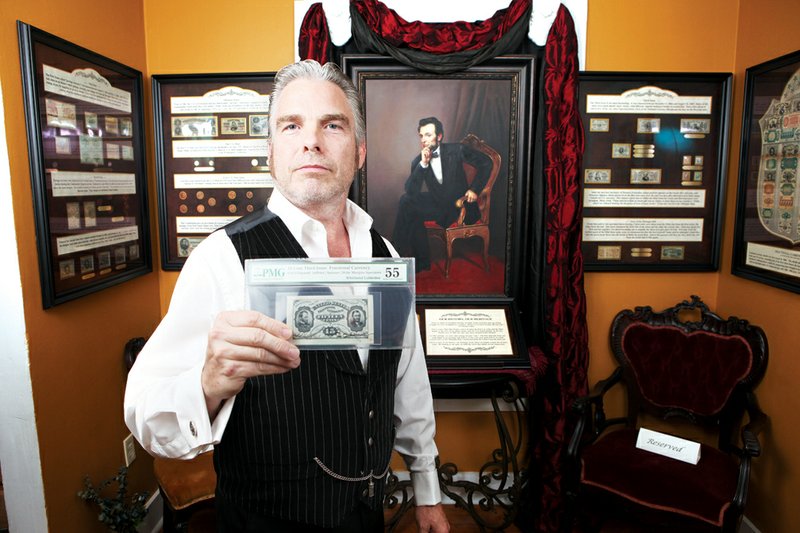CONWAY — For some coin collectors, it’s the peace silver dollar. For others, it may be the wheat penny or the buffalo nickel. But for Conway numismatist Wesley Smith, it’s the fractional currency of the Civil War era that sparks his interest.
Smith wants to share his U.S. Fractional Currency Series collection with the public and has set up an exhibit at the Faulkner County Library, 1900 Tyler St. in Conway. The exhibit will continue through Saturday.
Smith said the U.S. Treasury first issued fractional-currency notes in 1862 as a way to alleviate a coin shortage caused by Americans hoarding everyday staples and supplies, including coins, during the Civil War. These paper notes, which were printed in denominations of 3, 5, 10, 15, 25 and 50 cents, were used to make small change in the absence of coins until 1876.
Smith said the 5-, 10-, 25- and 50-cent denominations of the first issue bore the name “Postage Currency” across the top because they bore facsimiles of the then current 5- and 10-cent postage stamp.
“All issues after that were stamped and became known as ‘fractional currency.’ The small bills, measuring 2/12 to 5 inches across and ranging in value from 3 to 50 cents, evolved into what have become some of the least known and most beautiful examples of American collectible currency,” Smith said, noting that they are, for the most part, “still affordable due to their lack of exposure.”
Born outside Cleveland, Ohio, Smith lived in Indianapolis as a youth and collected coins for many years.
“My collection included my father’s and grandfather’s collections,” he said. “My collection grew, but it was always put away.
“Why collect, if you can’t see what you’re collecting?
“I hadn’t collected for many years, but while in Conway, I found a stitch in time, something hidden that many were unaware of, lasting less than a year and occurring only one time in our history. In 1862, postage, currency and coinage — these three merged into one.”
Smith, who is self-employed, said his current collection, which also includes some early coins from 1792, took three years to assemble. The piece de resistance in his collection is a 15-cent note that bears the images of Civil War Gens. Grant and Sherman.
Smith said 9,000 of the Grant-Sherman notes were printed but never circulated. However, in his exhibit, he tells “The Story of the Midnight Ride,” in which a select few of these notes were taken and circulated. Smith believes he has a note that was circulated.
“This exhibit is for the people,” Smith said.
In his exhibit, Smith asks those viewing the panels of currency to take a survey. He also has printed materials available to help the viewers as they move from panel to panel.
“I was almost 50, and I had never seen or heard of ‘postage currency,’ later to be known as ‘fractional currency,’” he said. “Since so many knew nothing about these events in history, I wanted to do something for the people, something new they can learn from. I believe by looking at the past, you can change the present, securing the future.”
Smith first showed his exhibit at Hendrix College, noting that the Fractional Currency Series ended in 1876, the same year Hendrix was founded. He said the first issue of fractional currency was released 150 years ago, on Aug. 21, 1862, which coincided with the beginning date of the 2012 Hendrix school year on Aug. 21, 2012.
From the Faulkner County Library, Smith hopes to take his exhibit on tour, eventually ending at the Smithsonian Institute in Washington, D.C. He hopes to include several stops along the way, including the William J. Clinton Presidential Library in Little Rock, the Lincoln Museum in Hodgenville, Ky., and the Lincoln Memorial University and Museum in Harrogate, Tenn. He said he pays respect to Lincoln since he was president during the time the Fractional Currency Series was put in place.
For more information on the Faulkner County Library exhibit, contact the library at (501) 327-7482, email Nancy@fcl.org, or visit the library’s pages on Facebook or Twitter.
